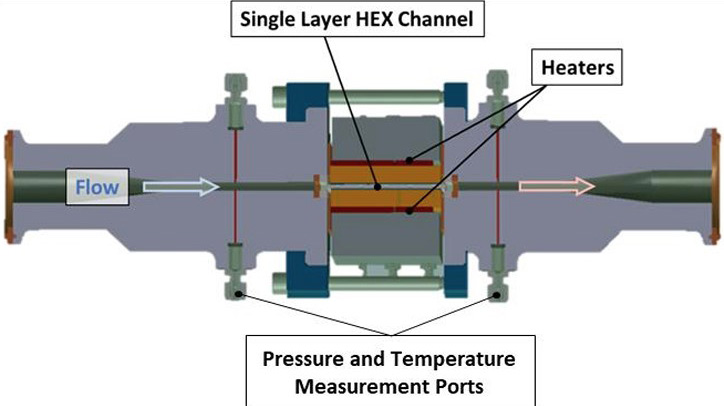


Section view of the Single-Layer Test Rig at RTRC
Problem
Traditional thermal management solutions for aerospace applications have relied on relatively simple geometries generated by resource intensive, low yield processes such as welding and brazing. Traditional design and manufacturing severely limit the efficiency and potential applications of thermal management solutions, resulting in unrealized reductions in size, weight, power, and cost. While aluminum or copper alloys are often preferred for low temperature thermal management applications and nickel alloys for high temperature applications, titanium alloys are heavily utilized in aerospace applications where high specific strength, corrosion resistance, and/or certain temperature regimes are required.
Objective
The purpose of the project was to develop a design guide for additive manufactured (AM) heat exchangers with complex internal geometries that incorporated surface roughness correction factors for heat transfer and pressure drop with a specific emphasis on the as-built and surface-finished conditions. The program aimed to advance U.S. manufacturing competitiveness in response to the topic area: Design Best Practices and Surface Finishing in Complex Thermal Management Applications.
Technical Approach
Raytheon Technologies Research Center (RTRC) determined an appropriate wavy fin specimen geometry (print orientation, channel dimensions, period, and amplitude of waviness, etc.) and experiment design for PBF-L Ti64 specimens in consultation with Collins Aerospace and Raytheon Missiles and Defense, America Makes, and Air Force representatives. Results of the program were readily utilized by the relevant stakeholders. Heat exchanger best practice dictates that fins are as thin as feasible, so the program targeted a fin thickness less than 0.5 mm. The external geometry of the specimen was designed to fit in the RTRC Single Layer Test Rig, and the target heat transfer and flow conditions aligned with target stakeholder applications. Specimens were printed at the Additive Manufacturing Process and Capabilities Center (AMPCC), located within RTRC. The specimens underwent stress relief and heat treatment in accordance with AMS 2801 and industry best practice for AM Ti64 to ensure the specimens were representative of production hardware throughout post-processing and testing. Specimens were performance tested over a broad range of flow conditions to determine the heat transfer and pressure drop correlations were representative of service environments.
Accomplishments
This project successfully printed, chemical milled, characterized, and tested AM heat exchanger geometries relevant to a broad range of aerospace applications, and compiled a pedigreed data set for future use. Relevant data were analyzed and reduced to generate heat exchanger correlations for pressure drop and heat transfer that could be easily scaled as required to size and predict the performance of complex heat exchangers in extreme environments (e.g., within a jet engine). The difference between tested samples with known roughness and computational fluid dynamics (CFD) predictions of performance assuming smooth walls was assessed and reported as augmentation factors from baseline predictions. The chemical milling process was able to remove all partially melted particles from the characterized samples, significantly reducing surface roughness without significantly affecting specimen geometry. Deficiencies in the chemical milling process were identified, however, and the project team was able to characterize those deficiencies, helping to determine probable key process characteristics (KPCs) and a path to address them with future work.
Project Participants
Project Principal

Other Project Participants
- America Makes
- Raytheon Missiles and Defense
- Collins Aerospace
Public Participants
- U.S. Department of Defense
